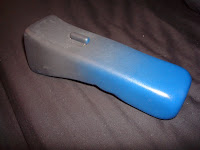



The first experiment I did was with the vacuum form. I took one 12"x12" sheet of 1/8" acrylic and attempted to form it over a piece of yellow foam. With 3 trials the heated to the point where it sags down in the middle, when I release the pressure and let up the form the acrylic didn't get sucked down around the yellow foam. Although I was unsuccessful I found the acrylic to be easily molded (and very hot).
I also tested the strength of different adhesives; Weld-on, Sobo glue, and wood glue. After 24 hours the wood glue easily snapped off while the Weld-on and Sobo held strong. With a little bit of applied pressure on them both had the Weld-on become detached and the Sobo glue was slightly flexible until it too snapped off. I also sprayed flat white spray paint on one side of the acrylic to see how well it adhered. The next day it held on strong while one side was flat white and the other glossy from the acrylic.
Finally I used the laser cutter to see how it could etch as well as cut various shapes. I set up shapes is small and tight curves as well as straight lines and points. They laser cutter took 3 tries to fully cut through the 1/8" acrylic. All of the pieces were cut with precision.











